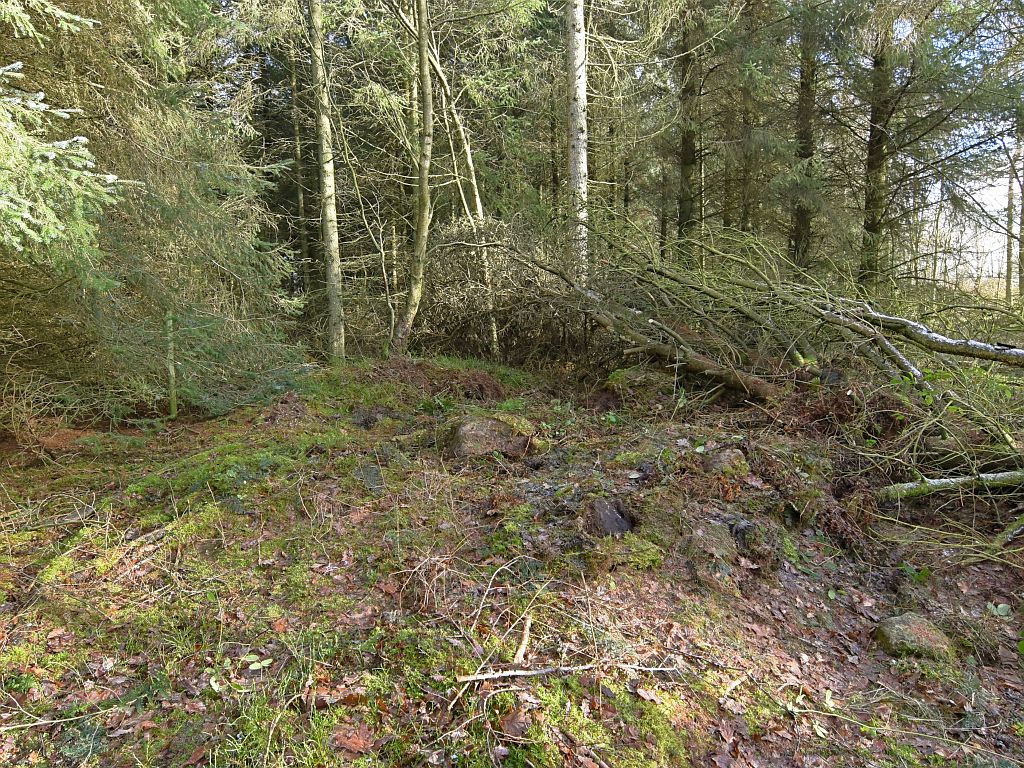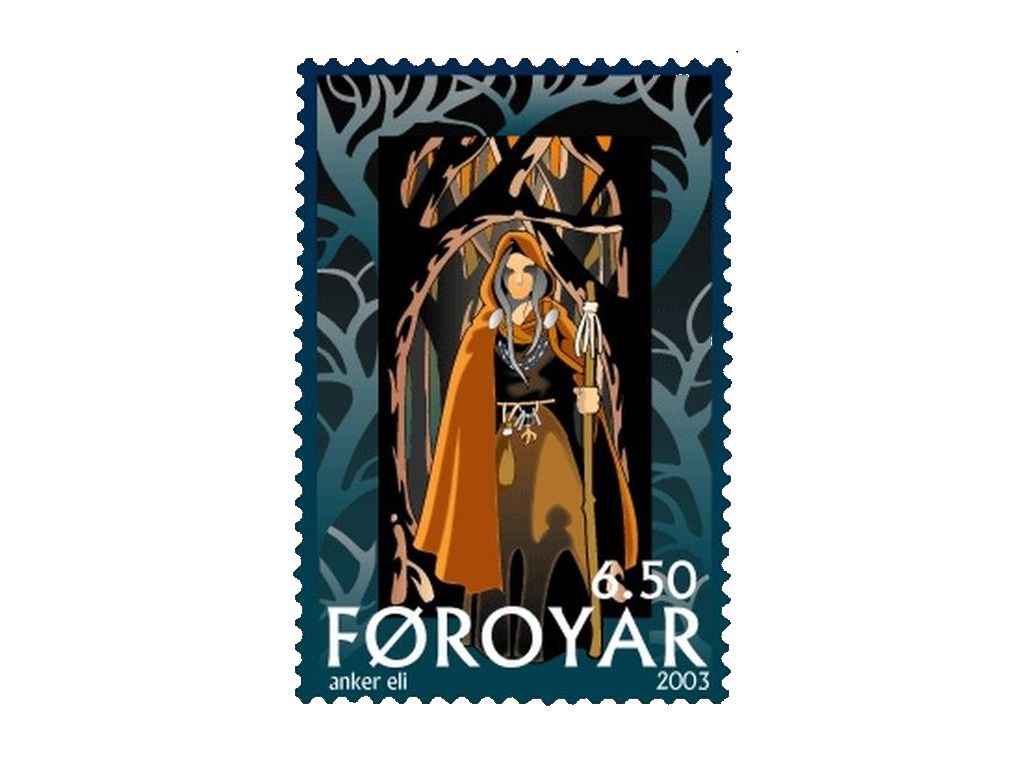
|
|
Court Moor and Nanny Howe - OS map (1856)
Map credit NLS |
The village of Kildale is located on the northern edge of the North York Moors, 4 miles to the south of Guisborough.
Here's a question - is it possible for a burial mound to also be a person? This might seem rather odd, but at first glance this appears to have been the case at Kildale - at least according to the local folklore.
The village sits in the river Leven valley, with the North York Moors stretching away to the south, and the Cleveland Hills forming the higher ground to the north. A narrow lane on the north side of the village leads up onto Coate Moor (originally Court Moor), with much of this hill top now covered by tree plantations. Before the forestry, there were three 'howes' or burial mounds standing approximately 45m apart on the eastern end of the ridge, with one of them being known as Nanny Howe. Frank Elgee (1933) visited the site in the early 1900's, and in addition to the burial mounds, he also noted stone walled enclosures and pits. Elgee also referred to the site's local name as 'the Devil's Court', from a tradition that witches used to gather there, and that Nanny Howe was named after a 'famous' local witch. In the regions dialect it was apparently not unusual for the possessive 's' to be dropped from a name, and so this is likely to have been 'Nanny's Howe'.
In the mid 1950's a rescue excavation of the burial mounds took place
ahead of tree planting on the moor. This excavation revealed Nanny Howe to be
a kerbed cairn composed of large stones covering a Bronze Age Beaker Burial.
At this time the walling seen on the moor by Elgee was no longer visible,
although several smaller cairns were noted in the area around the barrows.
Shortly after the excavations, the moor was ploughed over, destroying most of
the 'Devil's Court'.

|
|
Nanny Howe (YAJ 1966) |
However, the remains of Nanny Howe just about survived, although the mound had been left in its excavated state due to the planned ploughing. As it is, the huge ploughs used by the forestry stopped short of the cairn, and today (2020), the dug remains of the mound lay beneath a fallen Larch tree on the north side of the path leading up to Captain Cook's Monument. Several large stones forming part of the cairn structure can still be seen beneath the fallen branches and leaf litter. There also appears to be a pile of smaller, moss covered stones on the edge of the mound, perhaps removed during the excavation. It is rather sad to see the burial mound in it present state, considering that it survived on the hill for over 3000 years, and forms part of the area's local history and folklore.

|
|
The excavated Nanny Howe cairn (2020) |

|
|
The Witch (John R. Neill - 1918) |
Who was 'Nanny Howe'?
According to local folklore, a witch called 'Nanny' was associated in
some way with the prehistoric burial mound on the hill above Kildale village.
The historian John Walker Ord (1846) records a local story about the Devil
riding down the hill in a coach drawn by six black horses, in order to visit a
witch called "Nanny Howe". She lived with her husband in a cottage at the
bottom of the hill, and when the Devil arrived, Nanny took a swipe at him with
her broom, prompting the devil to respond with a swish of his tail, which sent
Nanny flying. This 'greeting' so offended the devil that he said he would be
taking a soul in compensation for the insult. Nanny's husband took to his
heels, and so, unperturbed, Nanny stepped forward and climbed into the
carriage, which then sped off back up the hill - presumably to the Devil's
Court. Ord must have also heard about the witches connection with the burial
mound, and either mistakenly, or for the purposes of the story, made 'Nanny
Howe' her full name.
Other stories seem to have existed in the area connecting 'Nanny' to the crags on Easby Moor, which were known as Nanny's Nook. A sharp bend in the road between Kildale and Commondale was known as Nanny's Hook, and a spring in the same area is still called Nanny's Spring. These last two locations are on the edge of Wayworth Moor, where numerous Bronze Age features also survive - including a large cairn near Nanny's Hook.
By the mid 1800's, when Ord was noting down his Nanny Howe story, the old local witches were being portrayed as comical characters. However, 50 years earlier there had still been a real belief in witchcraft and the supernatural, with most towns and villages having access to a wise man or woman. Although generally feared, these individuals provided various services to the community, including folk healing, using their 'powers' to locate stolen property, general divination, making protective talismans, and love charms etc. These 'cunning folk' were believed to gain their knowledge from the spirit world, and the earlier witchcraft trials shed some light on this practice. Details from Scottish witch trials suggest that contact with their helping spirits mainly took place at certain locations and at specific times of the year, e.g. Beltane, midsummer, Lammas, Halloween. In some cases, people requesting help or information from a witch /wise woman would have to wait until the next occasion when they met with their spirit helper. This might explain the tradition that witches visited locations at certain times of the year, and perhaps provides a hint as to why the "famous witch" Nanny of Kildale would be connected with a burial mound on the hilltop above her cottage.
Going further back in time there are records in Viking and Scandinavian
countries of women known as 'Völfa' - meaning a wise woman, seer or prophetess
(Völfa refers to a 'Wand or staff bearer'). An alternate name was Spaekona,
which survived in Scotland as the Spae-wife, a woman who could foretell the
future. The Völfa was an important part of Norse culture, being both honoured
and respected, but also feared. She would sit in the high seat when visiting a
chieftain's hall, and receive gifts before retiring to divine the future of
those who had invited her. One of the techniques associated with the Völfa was
known as 'Utiseta' (Out sitting), which was a ritual practice performed
outdoors at a spiritually potent location. One form of Utiseta took place at
burial mounds (Sitja á haugi) , where they would call upon the ancestral
spirits in order to gain knowledge of the past, present, and future. This
could involve sitting out for many hours on the mound either in meditation,
trance, or a deep sleep, where the spirits would appear and answer their
questions or give advice. A law against Utiseta was passed in Iceland in the
13th century, showing that the practice had also been taken there by
Scandinavian settlers, and was still being performed by them at that time.
Kildale is located in a region that was also heavily populated by Scandinavian settlers, and it seems that they too brought their pre Christian beliefs and practices with them. Only 2 miles to the north of Kildale stands the conspicuous peak of Roseberry Topping, which was still known as Othenesburg or 'Odin's mountain' in 12th century. Tinghowedale and Freebrough Hill appear to be other examples where they incorporated local landmarks into their religious practice. What became of their Völfa women after these settlers adopted Christianity (a long process, especially in rural areas) is unclear, but the 'services' they provided were still been performed by village wise women hundreds of years later.
'Nanny' seems to have been a generic folklore name for the village wise women in this area - some of whom were later regarded as witches. The Kildale story, although exaggerated, is perhaps a memory of one such woman who lived there, possibly in the mid 1700 (?). After a few generations the details about her would be mostly forgotten, but it was still remembered that she had some connection with a burial mound up on the hill. Could such a memory have arisen from her regularly visiting the cairn for some reason? Perhaps even going there to practice a form of the 'sitting out' ritual? A survival or remnant of the old Völfur tradition in this region? Elgee also noted the local belief that witches met on Court Moor, and if Nanny was a generic name for a witch, then this could have regarded as the 'Witch's Howe', but this still begs the question as to what was their reason for visiting this ancient cairn?
As with so much folklore, the lack of detail means that it is only possible to speculate on the beliefs behind the fragments that have actually been recorded. We will perhaps never know what the connection was between Nanny of Kildale and the Nanny's Howe burial mound above the village. That information is lost to us, unless of course someone fancies reviving the ancient practice of Utiseta and consulting the spirits......?
After thoughts
Several Norse/Viking Age burials found beneath Kildale church.
'Court
Moor' Kildale - 'Court Green' in a similar location on the Eston Hills, 5
miles to the north?
In the folklore, Nanny had a husband, so not the
usual image of a witch.
Was it thought that Nanny was buried in the
cairn? (Although the mound is several thousand years old)
Excavation of
Nanny Howe did uncover a secondary burial of possible Iron Age date. (?)
Utiseta
- any relevance to 'Seat' place names? Simon's Seat?
Has the Nanny name
any connection with the Norse deity 'Nanna' - daughter (?) of Freyja - goddess
of the Volfa tradition?
References
Elgee, F. (1933) Archaeology of Yorkshire.
Hayes,
R. (1966) Yorkshire Archaeological Journal. vol 41.
Ord, JW. (1846) "The
History and Antiquities of Cleveland .







Post a Comment